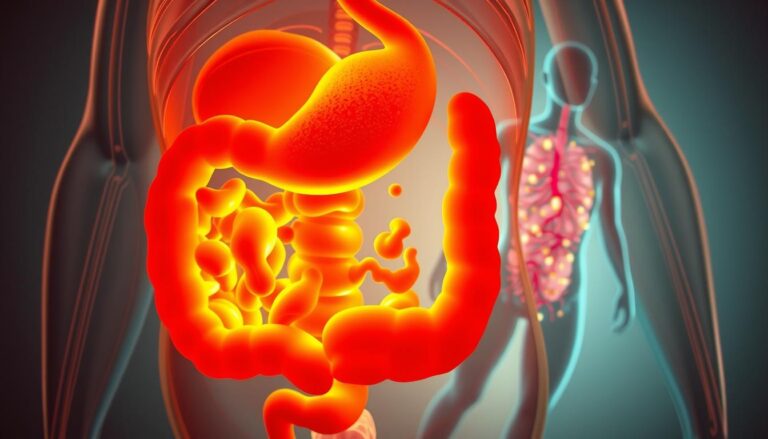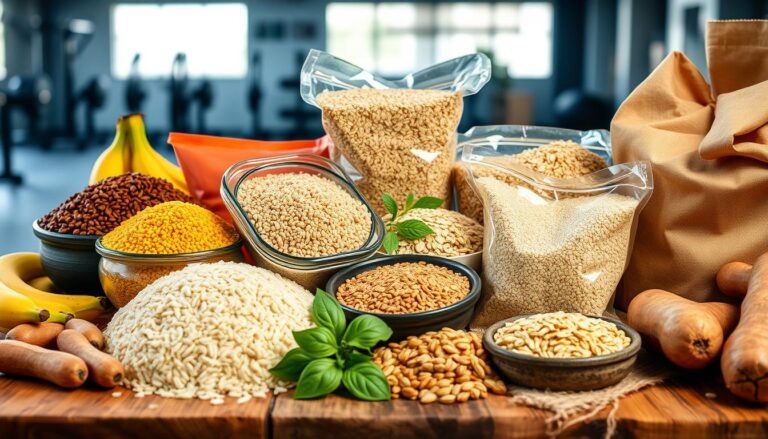A common concern about vegetarian and vegan diets is that they may lack sufficient protein. However numerous studies have shown that a well planned vegan diet can provide all the necessary nutrients for optimal health.
Various plant based protein sources can be incorporated into one’s diet, offering numerous health benefits, including improved digestion, heart health, and weight management.
Some snacks and foods are surprisingly high in protein per serving, making them excellent alternatives to animal-based sources.
Exploring the world of nutritious plant-based options can be a game changer for those looking to adopt a healthier lifestyle.
Key Takeaways
- Plant-based proteins offer numerous health benefits beyond muscle maintenance.
- A well-planned vegan diet can provide all necessary nutrients for optimal health.
- Various plant-based protein sources are available, including legumes, grains, and seeds.
- Incorporating protein-rich plant foods into your diet can support overall health and well-being.
- Healthy snacking options are available with plant-based protein sources.
Why Plant Based Protein Matters
The importance of plant based protein cannot be overstated, given its numerous health benefits. Protein is a crucial macronutrient that helps keep you full since it takes longer to digest, and it also supports various bodily functions, including muscle growth and hormone synthesis.
Plant-based proteins offer several advantages over animal proteins. Some key benefits include:
- Lower saturated fat content and higher fiber levels
- Support for muscle growth and repair, along with essential amino acids for overall bodily functions
- The ability to meet daily protein intake requirements without supplementation for most individuals
- Additional nutrients like antioxidants, phytochemicals, and fiber that support overall health
Health Benefits of Plant Protein
Consuming plant-based proteins has been associated with various benefits, including a reduced risk of chronic diseases such as heart disease and certain cancers. A well-planned diet rich in plant-based protein can provide all necessary nutrients.
Meeting Daily Protein Requirements
Understanding protein intake needs is vital for those following vegetarian or vegan diets. Fortunately, a well-planned plant-based diet can easily meet daily protein requirements, supporting overall health and well being.
Legume Based Protein Powerhouses
Among the most nutritious plant-based foods are legumes which include lentils, beans, and chickpeas. These foods are not only rich in protein but also in fiber and various essential nutrients making them a cornerstone of a balanced diet.
Lentils The Protein Packed Pulse
Lentils are a great source of protein and fiber containing 18 g of protein per cooked cup 198 g . They provide over half of the recommended daily fiber intake in a single serving, making them an excellent addition to a high protein diet.
Beans: Versatile Protein Sources
Different varieties of beans, such as kidney black, and pinto beans, are high in protein, with about 15 g of protein per cooked cup 170 g . They are also rich in minerals like iron zinc, and magnesium, contributing to their nutritional value.
Chickpeas From Hummus to Roasted Snacks
Chickpeas are versatile and can be used in various dishes, from hummus to roasted snacks. Roasted chickpeas offer a crunchy snack with about three times the protein of potato chips making them a healthier alternative.
| Legume | Protein per Serving | Key Nutrients |
|---|---|---|
| Lentils | 18 g per cooked cup | Protein, Fiber |
| Beans Kidney Black Pinto | 15 g per cooked cup | Protein Iron Zinc Magnesium |
| Chickpeas | Varies by preparation | Protein Fiber Vitamins |
Legumes are not only a concentrated source of plant based protein but also offer sustained energy due to their complex carbohydrates. Regular consumption of legumes has been associated with improved heart health, better blood sugar management, and reduced cholesterol levels.

Soy Based Protein Options
For those seeking plant-based protein sources, soy-based options are a highly nutritious choice. Soybeans are considered a whole source of protein providing the body with all the essential amino acids it needs.
Soy-based foods offer a range of nutritional benefits. They are rich in protein with 12-20 grams per 3.5 oz serving, and contain essential minerals like iron and calcium.
Tofu A Complete Protein Source
Tofu is a versatile soy product that can be prepared in numerous ways, offering 4-8 grams of protein per 3-ounce serving. It can be enjoyed warm or chilled making it a great snack or addition to meals.
Tempeh Fermented Protein Goodness
Tempeh is a fermented soy product that not only provides protein but also beneficial probiotics, supporting gut health. It contains B vitamins and minerals like magnesium and phosphorus.
Edamame Protein Rich Snacking
Edamame beans are an excellent protein-rich snack, with approximately 17 grams of protein per cup. They are also rich in folate, vitamin K, and fiber making them a nutritious choice.
The benefits of soy-based protein options are numerous:
- Soy based foods provide complete proteins making them nutritionally comparable to animal proteins.
- Tofu and tempeh offer versatility in cooking and can be prepared in various ways.
- Edamame is a nutrient-dense snack rich in protein and essential vitamins and minerals.
- Soy milk serves as a protein-rich plant milk alternative, often fortified with calcium and vitamin D.
Seitan and Wheat Protein
Seitan stands out as a protein-rich food that closely mimics the texture of meat making it a favorite among those transitioning to a plant-based diet. With approximately 25 grams of protein per 3.5 ounces, it is one of the richest plant-based protein sources available.
Understanding Seitan
Seitan also known as wheat meat or wheat gluten, is made from the gluten of wheat and is a popular protein source for vegetarians and vegans.
It is particularly noted for its ability to resemble the texture and appearance of meat when cooked, making it an excellent option for those looking for meat substitutes.
- Contains about 25 grams of protein per 3.5-ounce serving, making it one of the most protein-dense plant foods.
- Mimics the texture and appearance of meat, making it suitable for various cooking methods like grilling and stir frying.
- A good source of selenium and contains small amounts of iron, calcium, and phosphorus.
Cooking with Wheat Protein
Cooking with seitan is versatile as it can be grilled, stir-fried, or used in a variety of dishes traditionally made with meat. Its chewy texture makes it particularly suitable for dishes where texture is a key factor.
Key Considerations: While seitan is high in protein and offers several nutritional benefits it is not suitable for individuals with gluten related disorders due to its wheat gluten content.
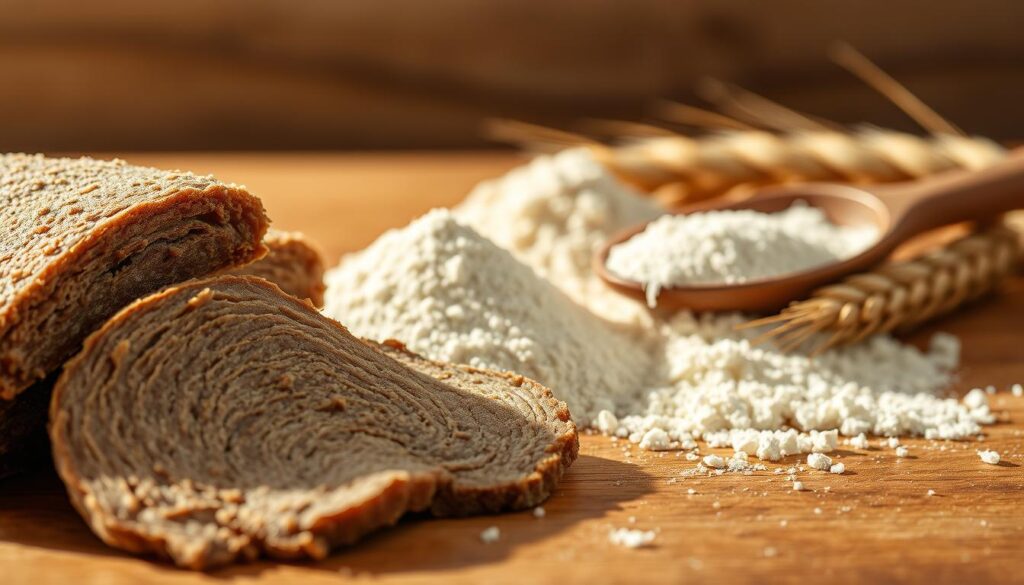
For athletes and individuals with higher protein requirements on a plant based diet seitan’s concentrated protein content makes it a valuable dietary addition. Commercial seitan products vary in flavor and texture with some containing additional ingredients for enhanced taste.
Nutritional Yeast A Protein Packed Flavor Booster
In the realm of plant-based eating, nutritional yeast emerges as a powerhouse of protein and other essential nutrients. This deactivated strain of Saccharomyces cerevisiae yeast is commercially available as a yellow powder or flakes.
Nutritional Profile and Benefits
Nutritional yeast is not only a concentrated source of protein but also offers a wealth of other nutrients. Half an ounce 16 g provides 8g of protein and 3g of fiber, making it an exceptionally nutritious addition to various dishes.
Fortified varieties are also rich in vitamins and minerals such as zinc magnesium copper and all the B vitamins, including vitamin B12.
| Nutrient | Amount per 1/2 oz 16g |
|---|---|
| Protein | 8g |
| Fiber | 3g |
| Vitamin B12 Fortified | Available |
Creative Ways to Use Nutritional Yeast
The cheesy, umami flavor of nutritional yeast makes it a versatile ingredient in plant-based cooking.
It can be used to enhance the flavor of sauces dressings and dips or as a topping for popcorn. Some creative ways to incorporate nutritional yeast include using it as a key ingredient in vegan cheese sauces or mixing it into dips for added nutrition and flavor.
High Protein Plant Based Foods and Snacks for On the Go
Busy lifestyles demand quick protein rich snack options that are both healthy and satisfying. Incorporating high protein, plant-based snacks into your daily routine can be easy and delicious.
Portable Protein Options
For those always on the move, portable protein options are a must. Examples include trail mixes with nuts and seeds, individually packaged hummus with vegetables, and plant based jerky alternatives. These convenient snacks are not only rich in protein but also offer a quick energy boost.
Quick Prep Protein Snacks
Preparing quick protein snacks at home can be simple and cost effective. Options like overnight chia pudding or roasted edamame are not only high in protein but also easy to prepare.
Incorporating these snacks into your diet can significantly boost your daily protein intake says a recent study. Batch preparing protein rich snacks using simple recipes can help maintain consistent protein consumption throughout busy weeks.
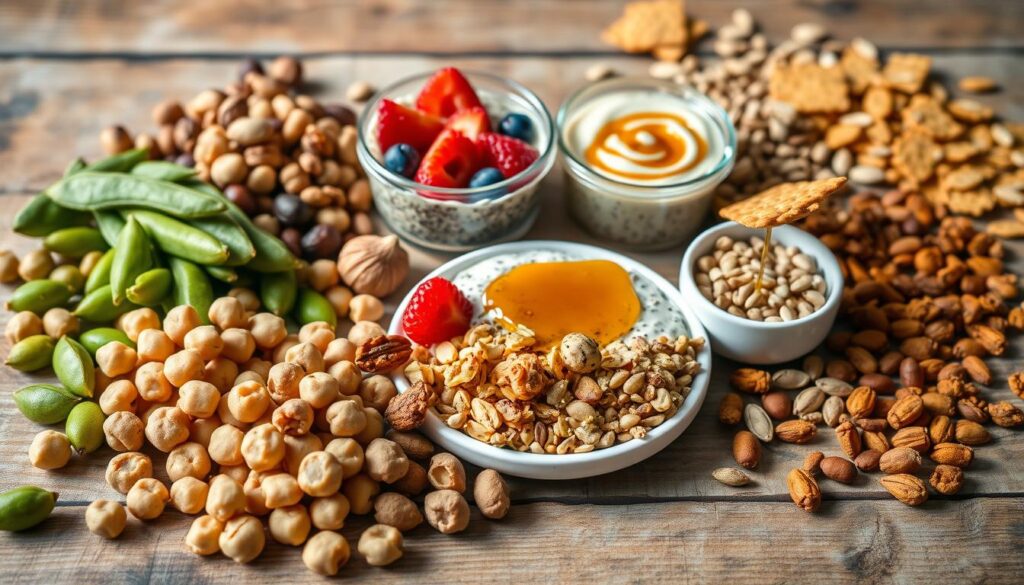
Some other quick and easy options include plant-based protein bars and energy balls made with nuts seeds, and plant protein powders. These snacks are not only convenient but also ensure you’re meeting your daily protein needs.
Protein Rich Seeds and Nuts
For those looking to boost their protein intake, seeds and nuts offer a nutritious and versatile option. These foods are not only rich in protein but also provide healthy fats making them nutritionally dense choices for plant based diets.
Hemp Seeds A Complete Protein Source
Hemp seeds are a standout in the plant based protein world because they contain all nine essential amino acids. With approximately 9 grams of protein per 3-tablespoon serving, hemp seeds are an excellent choice.
They are also rich in magnesium, iron, calcium, zinc and selenium, and offer an optimal ratio of omega-3 to omega-6 fatty acids.
Chia Seeds Tiny Nutritional Powerhouses
Chia seeds may be small, but they are packed with nutritional benefits. They provide about 5 grams of protein and 10 grams of fiber per ounce. Chia seeds are also a good source of iron calcium, selenium, and magnesium as well as omega-3 fatty acids and antioxidants.
Nuts and Nut Butters for Protein
Nuts and their derived products, like nut butters, are convenient sources of protein. One ounce of nuts contains between 5-7 grams of protein, with almonds, pistachios, and peanuts being among the highest in protein content. Nut butters offer around 7-8 grams of protein per 2-tablespoon serving.
| Food | Protein Content per Serving | Additional Nutritional Benefits |
|---|---|---|
| Hemp Seeds | 9g per 3-tablespoon serving | Rich in omega-3 and omega-6 fatty acids, magnesium iron calcium zinc and selenium |
| Chia Seeds | 5g per ounce | High in fiber iron calcium selenium magnesium and omega-3 fatty acids |
| Nuts e.g., Almonds, Pistachios | 5-7g per ounce | Good source of healthy fats, fiber, and various minerals |
Protein Rich Grains and Pseudocereals
Plant Based Milk and Yogurt Alternatives
The world of plant-based milk and yogurt alternatives is vast and varied, offering numerous options for those seeking dairy free nutrition. These alternatives have become increasingly popular, driven by consumer demand for products that are both nutritious and sustainable.
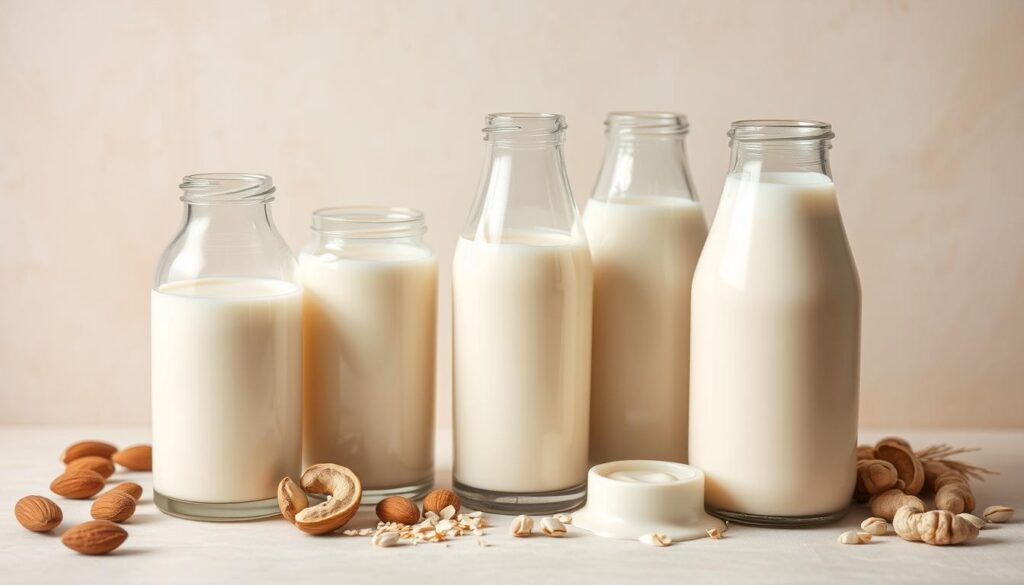
Soy Milk The Protein Champion
Soy milk stands out among plant based milks due to its high protein content, with approximately 6-8 grams per cup. Made from soybeans, it is often fortified with vitamins and minerals such as calcium, vitamin D, and vitamin B12, making it a nutritionally rich choice. However it’s crucial to choose unsweetened varieties to avoid sugar additives.
Plant Based Yogurts with Protein
Plant-based yogurts are diverse, made from various sources like nuts, legumes, and soy. The protein content varies significantly across different types.
Soy yogurt is particularly noteworthy, offering about 7 grams of protein per serving. Other yogurts such as those made from coconut or almond milk, generally contain less protein but can still be a healthy choice when unsweetened and fortified with nutrients.
Vegetables with Surprising Protein Content
Vegetables are often overlooked as a source of protein, but some are surprisingly rich in it. While not as dense in protein as legumes or grains, certain vegetables contribute significantly to daily protein intake.
Green Vegetables
Green vegetables like broccoli, spinach, and Brussels sprouts are notable for their protein content, offering around 4-5 grams per cooked cup. These vegetables are not only rich in protein but also in health-promoting fiber and vitamins.
Other Protein-Rich Produce
Other vegetables such as potatoes, sweet potatoes, and artichokes also contain a considerable amount of protein approximately 4-5 grams per serving. Even some fruits like guava and mulberries provide a decent amount of protein around 2-4 grams per cup.
Combining these with bean-based proteins or grains can create a balanced and nutritious meal, providing plenty of energy and supporting overall health.
Plant Based Protein Powders and Supplements
With the rise of plant-based diets, the demand for protein powders and supplements derived from plant sources has significantly increased. These supplements offer a convenient way to ensure adequate protein intake, particularly for individuals with higher protein needs or those who struggle to consume enough protein through whole foods alone.
Types of Plant Protein Powders
Plant-based protein powders come in various forms, catering to different tastes and nutritional needs. Common types include:
- Pea protein powder, known for its high protein content typically 15-20 grams per serving
- Rice protein, a hypoallergenic option suitable for sensitive stomachs
- Hemp protein, which offers a complete amino acid profile
- Blended plant protein formulations, combining multiple sources for a comprehensive amino acid profile
Comparison of Plant Protein Powders
| Protein Type | Protein Content per Serving | Amino Acid Profile |
|---|---|---|
| Pea Protein | 15-20 grams | High in BCAA |
| Rice Protein | 12-15 grams | Low in Lysine |
| Hemp Protein | 10-12 grams | Complete Amino Acid Profile |
How to Choose Quality Supplements
When selecting a plant-based protein powder, it’s crucial to consider the quality of the product. Look for supplements with minimal additives and artificial sweeteners. Third party testing certification is also a key factor, as it ensures the product’s quality and accuracy of protein content claims.
For those interested in a more personalized approach, creating homemade protein powder blends using ingredients like ground hemp seeds, chia seeds, and pumpkin seeds can be a viable alternative to commercial products.
Easy High Protein Plant Based Recipes
High-protein plant-based recipes offer a versatile and nutritious approach to meal planning. These recipes span various meal categories, providing a balanced and satisfying diet.
Breakfast Options
Starting your day with a protein-rich breakfast is easier than ever with plant-based options. Recipes like tofu scrambles chia puddings with protein rich plant milk and oatmeal with peanut butter provide excellent morning protein sources. For instance, a peanut butter and banana oatmeal bowl is a delicious and filling breakfast.
Lunch and Dinner Ideas
Lunch and dinner recipes are just as varied and nutritious. Ideas include bean-based burgers, lentil soups, tempeh stir-fries, and quinoa bowls, all delivering substantial protein alongside other essential nutrients. For example, a quinoa and black bean bowl with roasted vegetables is a nutrient-packed meal.
Protein Packed Snacks and Desserts
Snacks and desserts can also be high in protein. Energy balls made with black beans, dates, and peanut butter are a tasty and healthy option. Other ideas include protein-rich desserts like silken tofu cheesecakes or peanut butter cups made with natural ingredients.
| Recipe | Main Ingredients | Protein Content |
|---|---|---|
| Black Bean Energy Balls | Black beans, dates, peanut butter | High |
| Quinoa and Black Bean Bowl | Quinoa, black beans, vegetables | High |
| Peanut Butter Oatmeal | Oats, peanut butter, banana | Moderate |
These high-protein plant-based recipes not only provide the necessary protein for a healthy diet but also offer a variety of flavors and textures, making meal planning exciting and fulfilling. With minimal ingredients and preparation time, these recipes are accessible to everyone, regardless of cooking experience.
Combining Plant Proteins for Maximum Nutrition
Optimizing protein intake on a vegan diet involves more than just consuming high-protein foods it requires a thoughtful approach to combining different protein sources. This ensures that the body receives all the essential amino acids necessary for optimal health.
Complementary Proteins Explained
The concept of complementary proteins is crucial for those following a plant-based diet. It involves pairing foods that are low in certain amino acids with those that are high in those amino acids.
For example classic combinations include beans with rice, hummus with whole grain pita, and peanut butter with whole grain bread. Modern research indicates that consuming a variety of plant proteins throughout the day is sufficient for meeting amino acid needs.
Balanced Meal Planning
Balanced meal planning on a vegan diet involves ensuring adequate protein alongside other essential nutrients like vitamin B12 iron zinc, and omega-3 fatty acids. A well-planned vegan diet can provide numerous health benefits, including improved cardiovascular markers better weight management, and potentially reduced risk of certain chronic diseases. Focusing on minimally processed foods rather than relying heavily on ultra-processed vegan alternatives is key to optimal health outcomes.
| Food Combination | Amino Acids Provided | Nutritional Benefit |
|---|---|---|
| Beans and Rice | All essential amino acids | Complete protein source |
| Hummus and Whole Grain Pita | Varied amino acid profile | Satisfying and nutritious snack |
| Peanut Butter and Whole Grain Bread | Complementary amino acids | Protein-rich and filling |
Conclusion: Embracing Plant-Based Protein
As we’ve explored, plant-based protein sources are not only abundant but also nutritious, offering a wide range of health benefits. Incorporating these foods into your diet can be straightforward and rewarding. Plant-based protein sources provide a diverse array of options, from legumes and soy products to nuts, seeds, and whole grains, ensuring that you can meet your daily protein intake needs.
The health benefits of a vegan diet are well-documented, including weight loss and reduced risk of chronic diseases. Convenient snacks like nuts, seeds, and energy balls made from plant-based protein can help maintain energy levels.
By choosing a variety of these protein-rich foods, individuals can ensure they are getting enough protein while enjoying the other nutritional benefits of a plant-based diet, including a range of healthy snacks.
